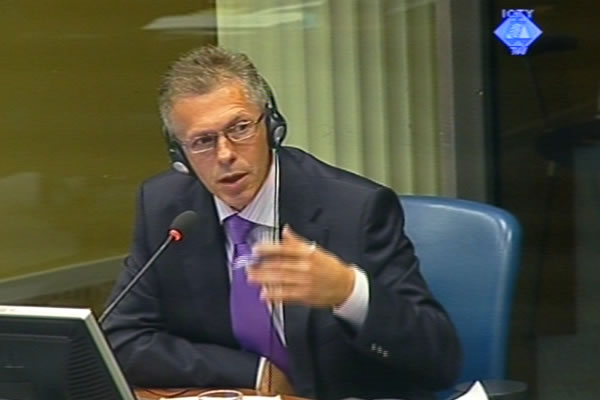Home
MLADIC’S DEFENSE SAYS ARMY HAD NOTHING TO DO WITH CRIMES IN OMARSKA
In the final part of their cross-examination of Mevludin Sejmenovic, Ratko Mladic’s defense tried to prove that the army in Prijedor obeyed the orders of the Crisis Staff, that Omarska was under the police’s jurisdiction and that Trnopolje was a transit center in which people didn’t starve
 Mevludin Sejmenovic, witness at the Ratko Mladic trial
Mevludin Sejmenovic, witness at the Ratko Mladic trial In the cross-examination of former SDA official Mevludin Sejmenovic, the defense of Ratko Mladic claimed that in 1992 in Prijedor the army merely implemented the policies conceived by the Crisis Staff. Milomir Stakic, former president of the municipality and the Crisis Staff in Prijedor is currently serving a 40-year sentence in a prison in France. The Tribunal found Stakic guilty of persecution, extermination, murder and deportation, committed from April to September 1992.
Mladic’s defense tried to prove that army personnel did not sit on the Crisis Staff, at least not after the SDS seized power in Prijedor. Defense counsel Branko Lukic confronted the witness with a report of the Public Security Station in Prijedor, which states that the Crisis Staff decided to launch an attack on the village of Hambarine in May 1992 in order to disarm and arrest those who had killed some soldiers. The report also states that the army intervened and put the village under control. Sejmenovic dismissed the defense counsel’s suggestion that the Crisis Staff issued orders to the army. As he said, the Serb army in Prijedor received orders from the Banja Luka Corps. The Banja Luka Corps in turn got its orders from ‘a higher level’, Sejmenovic explained.
Through the report of the Prijedor Public Security Station, Mladic’s defense is trying to prove that Omarska was controlled by the police. A number of judgments in other cases dealing with Prijedor before the Tribunal and the BH State Court confirmed that, the defense maintained. On the other hand, only Bosnian Serb politicians and police officials have been tried so far: Mladic is the first soldier in court for these crimes.
According to Sejmenovic, apart from the police there were also soldiers in Omarska. They moved around the prison camp going to and out of the hangar. One soldier even beat him up in the ‘white house’ and told him ‘now you will see how the soldiers hit’, Sejmenovic recounted. In the examination-in chief, Sejmenovic claimed that his fate was handed over to the military investigators in Omarska. Today Sejmenovic added that soldiers secured the prison camp in machine gun nests set up in front of the entrance.
The defense also tried to prove that Trnopolje was a transit center, not a prison camp, and that people in it weren’t starved. In the examination-in chief, the prosecution showed a photo of an exhausted and starved detainee of Trnopolje. Today the defense showed another photo from the same prison camp showing a ‘chubby man’, as the defense counsel called him. The physical condition of prisoners in Trnopolje varied from man to man; it depended on how long detainees stayed in the prison camp. Presiding judge Orie advised the parties to refrain from bringing up various ‘thin and well-fed persons’ because the ‘Trial Chamber knows what malnourished men look like’.
Before he left the courtroom, Sejmenovic thanked the Trial Chamber for the ‘hard work you do on behalf of justice and millions of people awaiting it’.
Linked Reports
- Case : Mladic
- 2012-10-02 ETHNIC CLEANSING WAS BASED ON THE 'PROPERTY MAP' OF PRIJEDOR
- 2012-10-02 RATKO MLADIC'S FIRST VICTIMS IN SARAJEVO
- 2012-10-01 PRISON CAMP FOR ETHNIC CLEANSING
- 2012-10-04 MLADIC’S RESPONSIBILITY FOR TERROR IN SARAJEVO
- 2012-10-05 DEADLINE TO CLEANSE ROGATICA
- 2012-10-05 COMMANDER AND SUPREME COMMANDER
